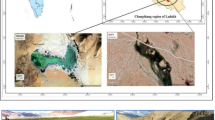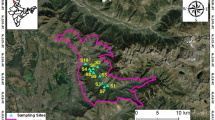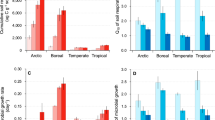Abstract
Over 200 years ago Alexander von Humboldt (1808) observed that plant and animal diversity peaks at tropical latitudes and decreases toward the poles, a trend he attributed to more favorable temperatures in the tropics. Studies to date suggest that this temperature–diversity gradient is weak or nonexistent for Bacteria and Archaea. To test the impacts of temperature as well as pH on bacterial and archaeal diversity, we performed pyrotag sequencing of 16S rRNA genes retrieved from 165 soil, sediment and biomat samples of 36 geothermal areas in Canada and New Zealand, covering a temperature range of 7.5–99 °C and a pH range of 1.8–9.0. This represents the widest ranges of temperature and pH yet examined in a single microbial diversity study. Species richness and diversity indices were strongly correlated to temperature, with R2 values up to 0.62 for neutral–alkaline springs. The distributions were unimodal, with peak diversity at 24 °C and decreasing diversity at higher and lower temperature extremes. There was also a significant pH effect on diversity; however, in contrast to previous studies of soil microbial diversity, pH explained less of the variability (13–20%) than temperature in the geothermal samples. No correlation was observed between diversity values and latitude from the equator, and we therefore infer a direct temperature effect in our data set. These results demonstrate that temperature exerts a strong control on microbial diversity when considered over most of the temperature range within which life is possible.
Similar content being viewed by others
Log in or create a free account to read this content
Gain free access to this article, as well as selected content from this journal and more on nature.com
or
Accession codes
References
Allen AP, Brown JH, Gillooly JF . (2002). Global biodiversity, biochemical kinetics, and the energetic-equivalence rule. Science 297: 1545–1548.
Altschul SF, Gish W, Miller W, Myers EW, Lipman DJ . (1990). Basic local alignment search tool. J Mol Biol 215: 403–410.
Amend JP, Shock EL . (2001). Energetics of overall metabolic reactions of thermophilic and hyperthermophilic Archaea and Bacteria. FEMS Microbiol Rev 25: 175–243.
Berg IA . (2011). Ecological aspects of the distribution of different autotrophic CO2 fixation pathways. Appl Environ Microbiol 77: 1925–1936.
Caporaso JG, Bittinger K, Bushman FD, DeSantis TZ, Andersen GL, Knight R . (2010a). PyNAST: a flexible tool for aligning sequences to a template alignment. Bioinformatics 26: 266–267.
Caporaso JG, Kuczynski J, Stombaugh J, Bittinger K, Bushman FD, Costello EK et al. (2010b). QIIME allows analysis of high-throughput community sequencing data. Nat Methods 7: 335–336.
Chao A . (1984). Nonparametric estimation of the number of classes in a population. Scand J Stat 11: 265–270.
Chu H, Fierer N, Lauber CL, Caporaso JG, Knight R, Grogan P . (2010). Soil bacterial diversity in the Arctic is not fundamentally different from that found in other biomes. Environ Microbiol 12: 2998–3006.
Clarke A, Gaston KJ . (2006). Climate, energy and diversity. Proc Biol Sci 273: 2257–2266.
Cole JK, Peacock JP, Dodsworth JA, Williams AJ, Thompson DB, Dong H et al. (2013). Sediment microbial communities in Great Boiling Spring are controlled by temperature and distinct from water communities. ISME J 7: 718–729.
Currie DJ, Mittelbach GG, Cornell HV, Field R, Guégan JF, Hawkins BA et al. (2004). Predictions and tests of climate-based hypotheses of broad-scale variation in taxonomic richness. Ecol Lett 7: 1121–1134.
Drake JW . (2009). Avoiding dangerous missense: thermophiles display especially low mutation rates. PLoS Genetics 5: e1000520.
Dunfield PF, Tamas I, Lee KC, Morgan XC, McDonald IR, Stott MB . (2012). Electing a candidate: a speculative history of the bacterial phylum OP10. Environ Microbiol 14: 3069–3080.
Edgar RC . (2010). Search and clustering orders of magnitude faster than BLAST. Bioinformatics 26: 2460–2461.
Engelbrektson A, Kunin V, Wrighton KC, Zvenigorodsky N, Chen F, Ochman H et al. (2010). Experimental factors affecting PCR-based estimates of microbial species richness and evenness. ISME J 4: 642–647.
Environment Canada (2013), Canadian climate normals 1971-2000. Available at http://climate.weatheroffice.gc.ca/climate_normals/results_e.html?stnID=1750andlang=eanddCode=1andprovince=NUandprovBut=Searchandmonth1=0andmonth2=12.
Evans KL, Warren PH, Gaston KJ . (2005). Species-energy relationships at the macroecological scale: a review of the mechanisms. Biol Rev Camb Philos Soc 80: 1–25.
Everroad RC, Otaki H, Matsuura K, Haruta S . (2012). Diversification of bacterial community composition along a temperature gradient at a thermal spring. Microbes Environ 27: 374–381.
Faith DP . (1992). Conservation evaluation and phylogenetic diversity. Biol Conserv 61: 1–10.
Fierer N, Jackson RB . (2006). The diversity and biogeography of soil bacterial communities. Proc Natl Acad Sci USA 103: 626–631.
Forster JR . (1778) Observations Made During a Voyage Round the World, on Physical Geography, Natural History and Ethic Philosophy. G. Robinson: London.
Fuhrman JA, Steele JA, Hewson I, Schwalbach MS, Brown MV, Green JL et al. (2008). A latitudinal diversity gradient in planktonic marine bacteria. Proc Natl Acad Sci USA 105: 7774–7778.
Gaston KJ . (2000). Global patterns in biodiversity. Nature 405: 220–227.
Giggenbach WO . (1994). Variations in the chemical and isotopic composition of fluids discharged from the Taupo Volcanic Zone, New Zealand. J Volcanol Geotherm Res 68: 89–116.
Gilles A, Meglécz E, Pech N, Ferreira S, Malausa T, Martin JF . (2011). Accuracy and quality assessment of 454 GS-FLX Titanium pyrosequencing. BMC Genomics 12: 245.
Grasby SE, Hutcheon I, Krouse HR . (2000). The influence of water-rock interaction on the chemistry of thermal springs in western Canada. Appl Geochem 15: 439–454.
Haas BJ, Gevers D, Earl AM, Feldgarden M, Ward DV, Giannoukos G et al. (2011). Chimeric 16S rRNA sequence formation and detection in Sanger and 454-pyrosequenced PCR amplicons. Genome Res 21: 494–504.
Hawkins BA, Field R, Cornell HV, Currie DJ, Guégan JF, Kaufman DM et al. (2003). Energy, water and broad-scale geographic patterns of species richness. Ecology 84: 3105–3117.
Hou W, Wang S, Dong H, Jiang H, Briggs BR, Peacock JP et al. (2013). A comprehensive census of microbial diversity in hot springs of Tengchong, Yunnan Province China using 16S rRNA gene pyrosequencing. PLoS One 8: e53350.
Huang Q, Dong CZ, Dong RM, Jiang H, Wang S, Wang G et al. (2011). Archaeal and bacterial diversity in hot springs on the Tibetan Plateau, China. Extremophiles 15: 549–563.
Humboldt Av . (1808) Ansichten der Natur mit wissenschaftlichen Erläuterungen. J.G. Cotta: Tubingen, Germany.
Knief C, Lipski A, Dunfield PF . (2003). Diversity and activity of methanotrophic bacteria in different upland soils. Appl Environ Microbiol 69: 6703–6714.
Lauber CL, Hamady M, Knight R, Fierer N . (2009). Pyrosequencing-based assessment of soil pH as a predictor of soil bacterial community structure at the continental scale. Appl Environ Microbiol 75: 5111–5120.
Mackelprang R, Waldrop MP, DeAngelis KM, David MM, Chavarria KL, Blazewicz SJ et al. (2011). Metagenomic analysis of a permafrost microbial community reveals a rapid response to thaw. Nature 480: 368–371.
Miller SR, Strong AL, Jones KL, Ungerer MC . (2009). Bar-coded pyrosequencing reveals shared bacterial community properties along the temperature gradients of two alkaline hot springs in Yellowstone National Park. Appl Environ Microbiol 75: 4565–4572.
Nemergut DR, Costello EK, Meyer AF, Pescador MY, Weintraub MN, Schmidt SK et al. (2005). Structure and function of alpine and arctic soil microbial communities. Res Microbiol 156: 775–784.
Neufeld JD, Mohn WW . (2005). Unexpectedly high bacterial diversity in arctic tundra relative to boreal forest soils, revealed by serial analysis of ribosomal sequence tags. Appl Environ Microbiol 71: 5710–5718.
Oren A . (2001). The bioenergetic basis for the decrease in metabolic diversity at increasing salt concentrations: implications for the functioning of salt lake ecosystems. Hydrobiologia 466: 61–72.
Pennanen T, Liski J, Bååth E, Kitunen VV, Uotila J, Westman CJ et al. (1999). Structure of the microbial communities in coniferous forest soils in relation to site fertility and stand development stage. Microb Ecol 38: 168–179.
Pollard W, Omelon C, Andersen D, McKay C . (1999). Perennial spring occurrence in the Expedition Fiord area of western Axel Heiberg Island, Canadian High Arctic. Can J Earth Sci 36: 105–120.
Pommier T, Canback B, Riemann L, Bostrom KH, Simu K, Lundberg P et al. (2007). Global patterns of diversity and community structure in marine bacterioplankton. Mol Ecol 16: 867–880.
Price MN, Dehal PS, Arkin AP . (2009). FastTree: computing large minimum evolution trees with profiles instead of a distance matrix. Mol Biol Evol 26: 1641–1650.
Pruesse E, Quast C, Knittel K, Fuchs BM, Ludwig W, Peplies J et al. (2007). SILVA: a comprehensive online resource for quality checked and aligned ribosomal RNA sequence data compatible with ARB. Nucleic Acids Res 35: 7188–7196.
Purcell D, Sompong U, Yim LC, Barraclough TG, Peerapornpisal Y, Pointing SB . (2007). The effects of temperature, pH and sulphide on the community structure of hyperthermophilic streamers in hot springs of northern Thailand. FEMS Microbiol Ecol 60: 456–466.
Ramos-Padrón E, Bordenave S, Lin S, Bhaskar IM, Dong X, Sensen CW et al. (2011). Carbon and sulfur cycling by microbial communities in a gypsum-treated oil sands tailings pond. Environ Sci Technol 45: 439–446.
Rousk J, Bååth E, Brookes PC, Lauber CL, Lozupone C, Caporaso JG et al. (2010). Soil bacterial and fungal communities across a pH gradient in an arable soil. ISME J 4: 1340–1351.
Stott MB, Crowe MA, Mountain BW, Smirnova AV, Hou S, Alam M et al. (2008). Isolation of novel bacteria, including a candidate division, from geothermal soils in New Zealand. Environ Microbiol 10: 2030–2041.
Takai K, Nakamura K, Toki T, Tsunogai U, Miyazaki M, Miyazaki J et al. (2008). Cell proliferation at 122 °C and isotopically heavy CH4 production by a hyperthermophilic methanogen under high-pressure cultivation. Proc Natl Acad Sci USA 105: 10949–10954.
Tobler D, Benning L . (2011). Bacterial diversity in five Icelandic geothermal waters: temperature and sinter growth rate effects. Extremophiles 15: 473–485.
Wang S, Hou W, Dong H, Jiang H, Huang L, Wu G et al. (2013). Control of temperature on microbial community structure in hot springs of the Tibetan plateau. PLoS One 8: e62901.
Yim LC, Hongmei J, Aitchison JC, Pointing SB . (2006). Highly diverse community structure in a remote central Tibetan geothermal spring does not display monotonic variation to thermal stress. FEMS Microbiol Ecol 57: 80–91.
Acknowledgements
The work was supported by an Alberta Innovates-Technology Futures (AITF) New Faculty Award and a Natural Sciences and Engineering Research Council of Canada (NSERC) Discovery Grant to PD, as well as by a Geothermal Resources of New Zealand (GRN) funding to MBS. CES was supported by doctoral fellowships from NSERC and AITF. ALB was supported by a postdoctoral award from NSERC.
Author information
Authors and Affiliations
Corresponding author
Ethics declarations
Competing interests
The authors declare no conflict of interest.
Additional information
Supplementary Information accompanies this paper on The ISME Journal website
Supplementary information
Rights and permissions
About this article
Cite this article
Sharp, C., Brady, A., Sharp, G. et al. Humboldt’s spa: microbial diversity is controlled by temperature in geothermal environments. ISME J 8, 1166–1174 (2014). https://doi.org/10.1038/ismej.2013.237
Received:
Revised:
Accepted:
Published:
Issue date:
DOI: https://doi.org/10.1038/ismej.2013.237
Keywords
This article is cited by
-
Unveiling microbial diversity in deep geothermal fluids, from current knowledge and analogous environments
Geothermal Energy (2023)
-
Using custom-built primers and nanopore sequencing to evaluate CO-utilizer bacterial and archaeal populations linked to bioH2 production
Scientific Reports (2023)
-
Benthic microbial biogeographic trends in the North Sea are shaped by an interplay of environmental drivers and bottom trawling effort
ISME Communications (2023)
-
Influence of Geochemistry in the Tropical Hot Springs on Microbial Community Structure and Function
Current Microbiology (2023)
-
Deciphering microbial communities and their unique metabolic repertoire across rock-soil–plant continuum in the Dayoukeng fumarolic geothermal field of the Tatun Volcano Group
Environmental Science and Pollution Research (2023)



